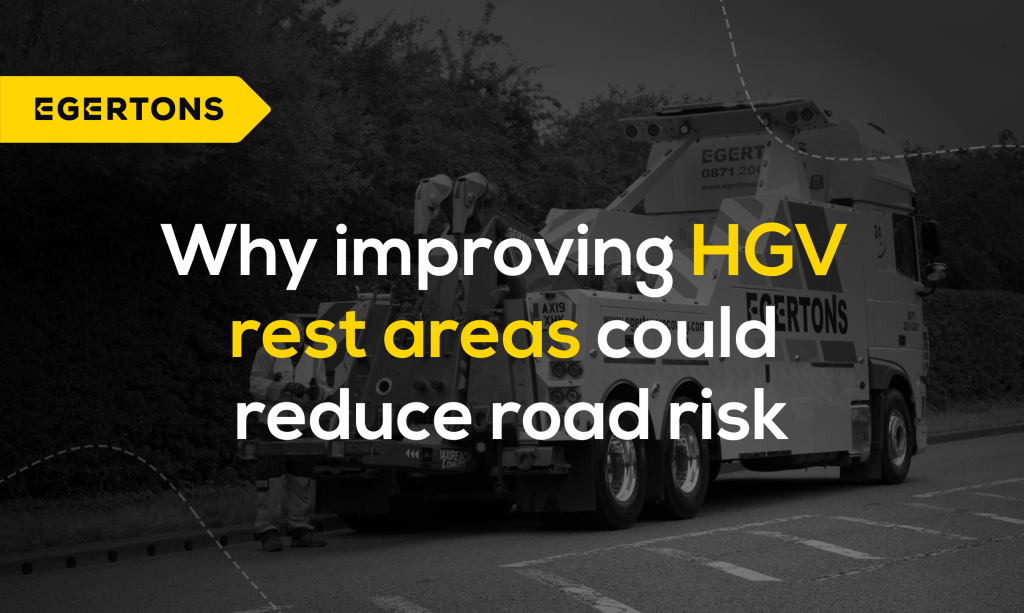Recently, the Department for Transport (DfT) announced an £8 million funding boost aimed at improving rest areas for Heavy Goods Vehicle (HGV) drivers across England. This initiative is part of the Government’s HGV Parking and Driver Welfare Grant Scheme, and implies that there’s a significant investment planned to support the welfare and safety of the haulage sector.
With the aim to enhance facilities such as showers, rest areas, and restaurants while increasing parking capacity and improving security, the funding marks a crucial step towards ensuring that HGV drivers have access to adequate rest and recovery facilities.
It’s been a long time coming for the industry, but there’s a bit more too it than just adding a few more cafes here and there.
Let’s find out what’s going on, and why it’s happening now.
Driving whilst tired is a hot government topic
Updated in April 2022, the UK government published the latest edition of their DVLA ‘Tiredness can kill: advice for drivers’ factsheet, asserting that there is no excuse for falling asleep at the wheel and it’s not an excuse in law.
The factsheet highlights that up to one 1/5 accidents on UK motorways and may be caused by drivers falling asleep at the wheel, however modern lifestyles which include early morning or late night starts, often lead to excessive tiredness for drivers behind the wheel due to unfamiliar body rhythms producing a natural increased tendency to sleep, particularly between the hours of midnight to 6am and 2pm to 4pm.
UK law also states that drivers could also face a driving ban and up to 14 years in prison from driving whilst tired. And if this wasn’t damaging enough for fleet operators, since distracted driving is linked to other poor driving behaviours such as harsh braking and speeding, it can often lead to wasted fuel and higher risk of mechanical problems resulting from those behaviours. This means additional costs for repairs and more chance of recovery needed.
HGV drivers have their own set of resting rules
For both HGV drivers and O-licence operators, tachograph rules state that as weekly maximum for commercial drivers, driving time cannot total any more than 56 hours, and a driver must take at least 45 minutes of breaks every 4.5 hours of driving, unless they take a rest period.
For fleet operators, it’s absolutely essential that they follow these regulations, as tachograph infringements can result in punishments such as monetary fines or even imprisonment, with the punishment depending on the severity of the breach. What’s more, VOSA can investigate up to 6 months of tachograph logs for driver hours offences, with no time limit for investigations into tachograph falsification.
However, the most important reason for adhering to tachograph regulations is simply to ensure that drivers are safe and competent behind the wheel. After all, commercial drivers are known to work long hours with flexible sleeping patterns, therefore it’s their employer’s duty of care to ensure they have adequate rest periods and never driver past their allotted hours. The results of not meeting these requirements could be catastrophic if an accident were to occur due to breaks being missed.
Understanding the importance of general rest for HGV drivers
Needless to say, HGV drivers play a vital role in keeping the economy moving, as they’re constantly delivering essential goods and supplies throughout the country day and night. However, with strict regulations enforcing mandatory breaks and rest periods for drivers, ensuring access to high-quality rest areas is absolutely essential, as those drivers don’t just need to rest, they need to rest properly.
Fatigue-related accidents are a significant concern in the haulage industry, so much so that recent research from IAM RoadSmart highlighted the concerning trend amongst commercial drivers that 10% had momentarily closed their eyes because they were so tired behind the wheel. 10% also admitted that they had been suddenly shocked after hitting the rumble strip, and 40% had turned down heating or opened windows to keep them awake.
Further to this, the road safety charity, Brake, outlined that tiredness is a major factor in causing many road traffic accidents, with their study highlighting that about 40% of tiredness-related accidents involve commercial drivers.
With this, we see that HGV drivers are looking for ways to avoid feeling tired behind the wheel, rather than actively taking the opportunity to seek comfortable and safe rest areas where they can recharge and recuperate.
Is this because they would prefer to just “keep plodding along”, or because the facilities they need simply aren’t there for them?
The impact of improved rest areas on road safety
By investing in the improvement of roadside facilities, the DfT aims to enhance the quality of HGV drivers’ rest and recovery, ultimately leading to safer roads by providing drivers with access to well-equipped rest areas which encourage them to take regular breaks.
What’s more, upgraded facilities can also contribute to the overall well-being and job satisfaction of drivers, fostering a safer and more resilient haulage sector too. Not to mention they’d also be adhering to mandated rest periods and reducing the risk of fatigue-related incidents at the same time.
Improving rest areas could also address the HGV driver shortage too
The rest area initiative is also part of the Government’s broader strategy to address the shortage of HGV drivers and bolster recruitment and retention efforts, with the idea that investing in driver welfare and providing access to modern, comfortable rest areas are essential steps towards attracting new talent to the industry and retaining experienced drivers.
Alongside other initiatives such as Skills Bootcamps and increased driver testing capacity, the enhancement of rest areas demonstrates a commitment to supporting the haulage sector and ensuring its sustainability for the future, all leading towards positive movements for the wider sector.
Industry response and future opportunities
In response to the news, industry stakeholders have welcomed the announcement of funding for rest area improvements, supporting the importance of better facilities for HGV drivers overall, with Managing Director of the Road Haulage Association (RHA), Richard Smith, expressing his optimism about the benefits that these upgrades will bring to drivers.
Smith has also urged operators to take advantage of funding opportunities, and what with additional funding available through the Government’s match-funding scheme, encourages operators to continue upgrading rest areas and further enhancing driver welfare across England.
Improving HGV rest areas is not only a matter of convenience, but is also a crucial step towards enhancing road safety and supporting the well-being of HGV drivers overall.
This recent funding announcement from the DfT represents a significant investment in the welfare of the haulage sector and underscores the importance of providing drivers with access to modern, comfortable rest facilities. But whilst the Government is clearly taking the proactive steps to addressing challenges within the industry and ensure its long-term sustainability, accidents can always happen, and operating a vehicle demands total concentration and focus at all times.
That’s why it’s so important to appoint the right HGV recovery partner
Egertons are one of the UK’s leading vehicle rescue and recovery operators, with services stretching from breakdown recovery to specialist assistance and recovery, available 24/7/365 service across the country.
But the main reason choose us? Because our fleet of incident response vehicles, range of equipment available on hand and the technology our fleet is equipped with, allows us to deploy the exact right vehicles, first time, helping to keep your vehicle downtime to an absolute minimum and ensure recovery takes place as safely and efficiently as possible.
What’s more, we also hold PAS 43, ISO 9001 and NNHS Sector 17 accreditations, helping to ensure that all our recoveries and repairs are completed to the very highest industry standards.
We’re the preferred vehicle rescue and recovery operator for UK fleets to rely on, no matter what.
In other words, when you need us, we’ll be right here.


